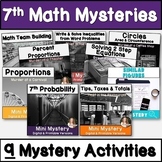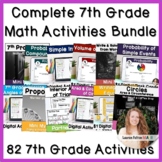7th Grade Probability Activity Mini Mystery | Simple and Compound Probability
- Zip
- Google Apps™

What educators are saying
Also included in
- Are you looking to ENGAGE your 7th grade math students? This digital & printable Activity Bundle will have your students excited about solving math problems! With 9 Mystery Activities, these are perfect end of unit reviews, Fun Friday activities, or monotony-breaking games! Eight of the activitiPrice $22.05Original Price $31.50Save $9.45
- Looking for the perfect combination to round out your probability unit? This bundle includes digital friendly notes & activities for distance learning. With Graphic Notes, a Mini Mystery, and a Digital Activity Pack, your students will get all the practice they need finding the probability of siPrice $8.00Original Price $10.50Save $2.50
- 85 7th Grade Math Activities and Growing! Get a yearlong bundle of all the 7th Grade Activities in my store for one low price! Every Seventh Grade Math activity I add to my store will also be added to this bundle11 Digital Activity Packs - Each with Three Activities (33 Total)Comparing & OrderinPrice $131.78Original Price $188.25Save $56.47
Description
This low-prep simple and compound probability activity is an engaging way for students to practice working with probability, sample spaces, and simple & compound events! (Digital & Printable Versions)
Students are given character cards when they enter the room and assume the role of a hotel guest. Their relaxing stay at the hotel is interrupted when a hotel staff member is found dead. The murderer left a clue sheet and students must work together, solving the probability clue sheet to figure out who the murderer is!
The digital version of this activity is created in Google Slides and includes a full set of instructions for students and teachers.
⭐This Product Includes⭐
- Murder Mystery Story PowerPoint
- Murder Mystery Clue Sheet
- 35 Unique Suspect/Character Cards
- Full Answer Key & Set-Up Guide
- Optional PDF to Print Suspect Cards as Name Badges on Avery 25395 Badges
- Digital Version of Activity, Complete with Student & Teacher Instructions
- Video Instructions for Teacher - How to Assign Through Google Classroom
This product is part of a 7th Grade Mystery Bundle! Purchase the Bundle & Save!
7th Grade Math Activity Bundle! CCSS & TEKS Aligned!
Related Products
⭐ Probability Distance Learning Digital Activity Pack!
⭐ Probability of Simple Events Activity! Partner Pack!
⭐ 7th Grade Probability Notes Printable Distance Learning | Graphic Notes!
⭐ Compound Probability Activity! Partner Pack!








